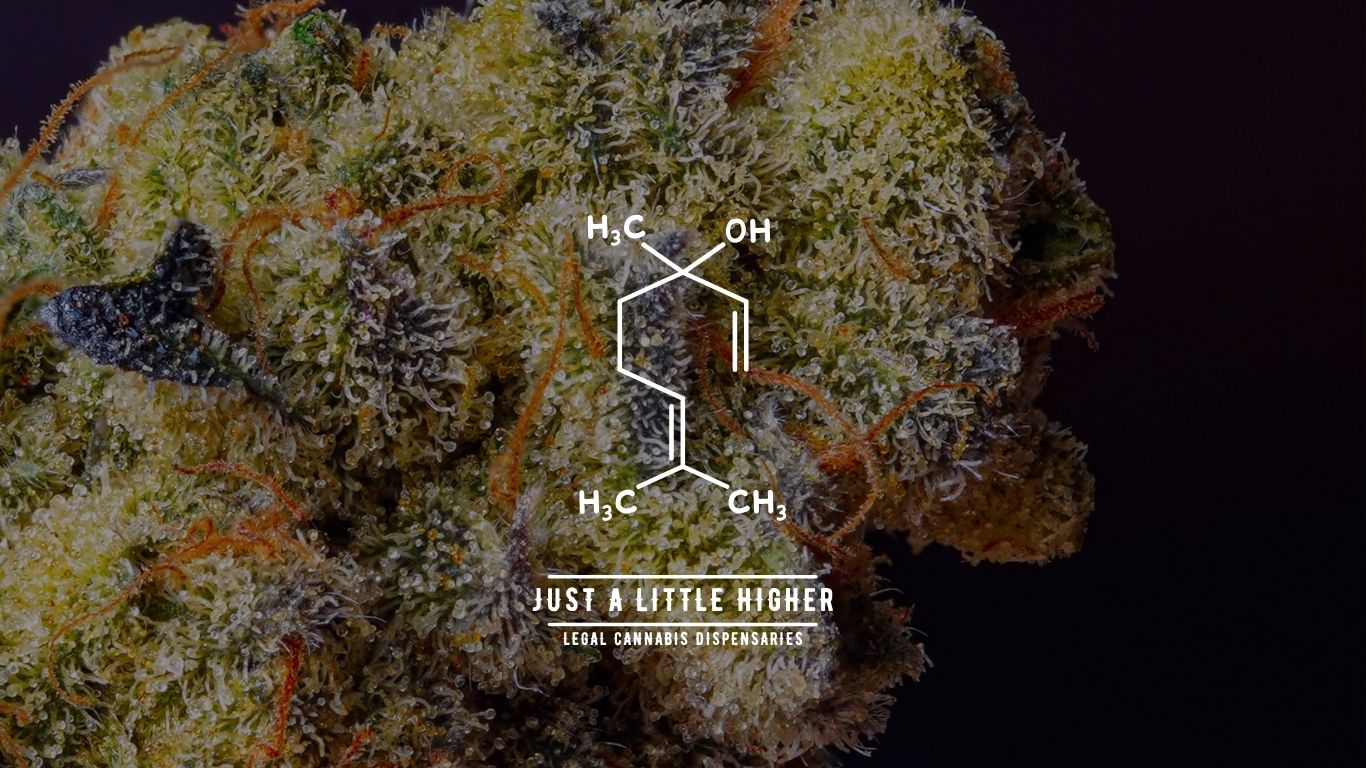When you walk into any Just A Little Higher Cannabis dispensary, you’re immediately greeted by an array of distinctive aromas – some earthy and piney, others citrusy and bright, and still others sweet and floral. These captivating scents aren’t just pleasant background notes; they’re the result of complex organic compounds called terpenes that play a crucial role in defining not only how cannabis smells and tastes, but also how it makes you feel.
While most cannabis consumers focus primarily on cannabinoids like THC and CBD when selecting products, understanding terpenes can revolutionize your cannabis experience. These aromatic molecules are the unsung heroes of the cannabis plant, working behind the scenes to create the nuanced effects that make each strain unique.
What Exactly Are Terpenes?
Terpenes are organic compounds found throughout nature that give plants their distinctive aromas and flavors. They’re not unique to cannabis – in fact, terpenes are responsible for the scent of lavender, the citrusy smell of oranges, the piney aroma of forests, and even the distinctive smell of hops in beer. These compounds serve as natural defense mechanisms for plants, deterring pests while attracting beneficial pollinators.
In the cannabis plant, terpenes are produced in the same resinous glands (trichomes) that create cannabinoids like THC and CBD. This co-location isn’t coincidental – it’s part of nature’s sophisticated design that allows these compounds to work together synergistically.
Currently, researchers have identified over 200 different terpenes in cannabis, though most strains contain only a handful in significant concentrations. Each strain’s unique terpene profile creates its distinctive “fingerprint” of aroma, flavor, and effects.
The Science Behind Terpenes: How They Work
The Entourage Effect
The most important concept to understand about terpenes is their role in what scientists call the “entourage effect.” This phenomenon describes how different cannabis compounds work together to create effects that are greater than the sum of their individual parts.
Rather than THC or CBD working in isolation, terpenes can modify and enhance these cannabinoids’ effects. For example, the terpene myrcene may enhance THC’s sedating properties, while limonene might elevate mood and energy levels. This interaction explains why two strains with identical THC percentages can produce completely different experiences.
Interaction with Your Body
Terpenes interact with your body through multiple pathways. Some bind directly to cannabinoid receptors in your endocannabinoid system, while others influence neurotransmitter activity or affect the permeability of cell membranes. This multi-faceted interaction allows terpenes to modulate not just the intensity of cannabis effects, but their specific character and duration.
The Most Important Cannabis Terpenes
Myrcene: The Relaxation Enhancer
Myrcene is one of the most abundant terpenes in cannabis and is largely responsible for the sedating effects associated with indica strains. This terpene produces earthy, musky aromas with hints of cloves and is also found in mangoes, lemongrass, and hops.
Effects and Benefits:
- Enhances muscle relaxation
- Promotes sedation and sleep
- May have anti-inflammatory properties
- Can increase cell membrane permeability, potentially allowing other compounds to take effect more readily
Common in: Traditional indica strains, including many OG and Kush varieties
Limonene: The Mood Lifter
Limonene creates the bright, citrusy aromas found in many sativa-dominant strains. As its name suggests, this terpene is also abundant in citrus fruits and is known for its mood-elevating properties.
Effects and Benefits:
- Elevates mood and reduces stress
- May have anti-anxiety properties
- Supports focus and mental clarity
- Potential anti-inflammatory and antifungal effects
Common in: Citrus-scented strains like Lemon Haze, Super Lemon OG, and many Jack Herer phenotypes
Pinene: The Focus Enhancer
Pinene produces the fresh, piney aroma reminiscent of coniferous forests. It’s the most common terpene in nature and comes in two forms: alpha-pinene (pine, rosemary) and beta-pinene (hops, parsley).
Effects and Benefits:
- Promotes alertness and mental clarity
- May counteract some of THC’s short-term memory effects
- Potential bronchodilator properties
- Anti-inflammatory effects
Common in: Strains with pine or fresh herb aromas, including many Haze varieties and classic sativas
Linalool: The Calming Influence
Linalool produces floral, lavender-like aromas and is prized for its calming properties. This terpene is also found in lavender, mint, and coriander.
Effects and Benefits:
- Promotes relaxation without heavy sedation
- May have anti-anxiety and antidepressant properties
- Potential pain-relieving effects
- May help with sleep disorders
Common in: Purple strains and those with floral, sweet aromas
Caryophyllene: The Unique Therapeutic Terpene
Beta-caryophyllene is unique among terpenes because it can directly bind to CB2 cannabinoid receptors, technically making it both a terpene and a cannabinoid. It produces spicy, peppery aromas and is also found in black pepper, cloves, and cinnamon.
Effects and Benefits:
- Anti-inflammatory properties
- Potential pain relief
- May help with anxiety and depression
- Gastroprotective effects
Common in: Strains with spicy, peppery notes, including many Cookies and Diesel varieties
Humulene: The Appetite Suppressant
Humulene produces earthy, woody aromas with subtle spicy notes. Unlike many other cannabis compounds, humulene may actually suppress appetite rather than stimulate it.
Effects and Benefits:
- Potential appetite suppression
- Anti-inflammatory properties
- May have antibacterial properties
- Energizing effects
Common in: Strains with earthy, hoppy aromas, as this terpene is also abundant in hops
How Terpenes Influence Cannabis Effects
Beyond Indica vs. Sativa
Traditional cannabis classification relies heavily on the indica versus sativa distinction, but modern cannabis science suggests that terpene profiles are far more predictive of effects than plant morphology. A strain’s terpene composition can tell you much more about its likely effects than whether it’s technically indica or sativa.
For example, a strain high in myrcene and linalool will likely produce relaxing, sedating effects regardless of its indica or sativa genetics. Conversely, a strain rich in limonene and pinene will probably be energizing and uplifting, even if it comes from indica parentage.
Customizing Your Experience
Understanding terpenes allows you to make more informed decisions about cannabis products. Rather than simply looking at THC percentages or indica/sativa labels, you can select strains based on their terpene profiles to achieve specific desired effects:
For relaxation and sleep: Look for strains high in myrcene, linalool, and caryophyllene For energy and focus: Seek out products rich in limonene, pinene, and terpinolene For balanced effects: Choose strains with diverse terpene profiles that combine both relaxing and uplifting compounds
Terpenes in Different Cannabis Products
Flower Products
In cannabis flower, terpenes are naturally preserved in their original ratios, providing the most authentic expression of a strain’s genetics. However, terpene content can be affected by cultivation methods, curing processes, and storage conditions.
Concentrates and Extracts
Many cannabis concentrates lose terpenes during extraction processes, which is why some manufacturers add terpenes back into their products. These can be cannabis-derived terpenes (CDT) from the same plant or botanical terpenes from other sources.
Edibles and Infusions
Cannabis edibles typically don’t retain significant terpene content due to processing methods, though some manufacturers are now creating terpene-enhanced edibles to provide more targeted effects.
Maximizing Terpene Benefits
Proper Storage
Terpenes are volatile compounds that can degrade when exposed to heat, light, and air. Store your cannabis in cool, dark places in airtight containers to preserve terpene content.
Consumption Temperature
When vaporizing cannabis, lower temperatures (315-400°F) better preserve terpenes, while higher temperatures may destroy these delicate compounds before you can benefit from them.
Fresh is Best
Terpene content naturally decreases over time, so fresher cannabis will generally provide more pronounced terpene effects than older products.
The Future of Terpene Research
Cannabis terpene research is still in its early stages, with new discoveries being made regularly. Scientists are investigating how different terpene combinations interact, how individual genetics affect terpene sensitivity, and how terpenes might be used therapeutically.
As our understanding grows, we can expect to see more sophisticated cannabis products designed around specific terpene profiles, potentially leading to more predictable and customizable cannabis experiences.
Experience Terpenes at Just A Little Higher
At Just A Little Higher Cannabis, our knowledgeable budtenders are trained to help you understand how different terpene profiles might affect your experience. Whether you’re visiting our Upper West Side, Murray Hill, Briarwood, Queens Plaza, or Troy locations, our team can guide you toward products that match your desired effects based on their terpene content.
We carry detailed lab reports for our products that include terpene profiles, allowing you to make informed decisions based on science rather than guesswork. Our rotating selection ensures you’ll always find strains with diverse terpene profiles to explore.
Understanding terpenes transforms cannabis from a simple recreational product into a sophisticated tool for customizing your experience. Whether you’re seeking relaxation, creativity, focus, or pain relief, the right terpene profile can help you achieve your goals more effectively.
Next time you visit one of our locations, ask about terpene profiles and discover how these aromatic compounds can elevate your cannabis journey. The world of terpenes offers endless possibilities for exploration and personalization – and we’re here to guide you through every aromatic step of the way.




